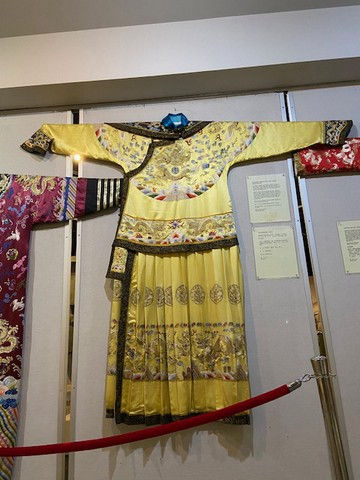Department:
The Museum Proper
Replica or Original:
On Display, In Storage, or in a Private Offsite Collection:
On Display
Primary Material:
Medium:
Dimensions:
Classification/Category:
Personal Objects
Specific Classification:
Notable Signatures,
Inscriptions, and/or Markings:
Donated by:
Unknown
Accession Number
Artifact Date:
Artifact Era/Dynasty:
Unknown
Creator:
Chinese
Creator Ancestry:

The color of the garment was also significant and quite strictly regulated. Different shades denoted different ranks, and the bright golden yellows were reserved solely for the Emperor and the Imperial family. Most commonly, the Emperor’s robes could be found in the following four colors:
BRIGHT YELLOW - The most prestigious color. This bright yellow court robe is the most formal garment, and it is worn by the Emperor while attending grand ceremonies such as those on New Year's Day, the Winter Solstice, birthdays, and the days when sacrifices were offered to ancestors at the Imperial Ancestral Temple. The robe is made from bright yellow satin embroidered with gold dragon designs.
BLUE - Worn at ceremonies offering sacrifices to heaven to pray for good harvest and rain.
RED - Worn at ceremonies offering sacrifices to the sun.
BLUISH-WHITE - Worn at ceremonies offering sacrifices to the moon.
Auspicious symbols were also commonly featured in court attire, and each design held its own symbolic meaning. The Twelve Symbols of Ancient Imperial Authority often adorned the robes of the Emperor, and they consisted of the sun, moon, three-star constellation, sacred mountains, fu pattern, axe head, dragon, pheasant or phoenix, seaweed, flames, sacrificial goblets, and the grain.
The sun, moon, and three-star constellation represent the heavens and the universe.
The sacred mountains symbolize the Emperor’s ability to rule over the earth and stability. The bowed fu symbol represents the ability to distinguish between right and wrong.
The axe head demonstrates the Emperor’s power to act decisively.
Together, the dragon and the phoenix represent the natural world, symbolizing strength and refinement. If you look closely, you will find that dragons have exactly five claws on each foot, as the five-clawed dragon is the Emperor’s sacred symbol.
The seaweed denotes purity and the flames symbolize intellectual brilliance.
The twin goblets represent imperial loyalty and respect, and finally, the grain calls upon the idea of nourishment and prosperity.

Artifact Date:
Artifact Era/Dynasty:
Creator:
Unknown
Creator Ancestory:
Chinese
Catalogue Entry
Online References:
Department:
The Museum Proper
On Display, In Storage, or in a Private Offsite Collection:
On Display
Replica or Original:
Emperor and Empress Court Attires
Listen
Classification/Category:
Personal Objects
Specific Classification:
Notable Signatures,
Inscriptions, and/or Markings:





